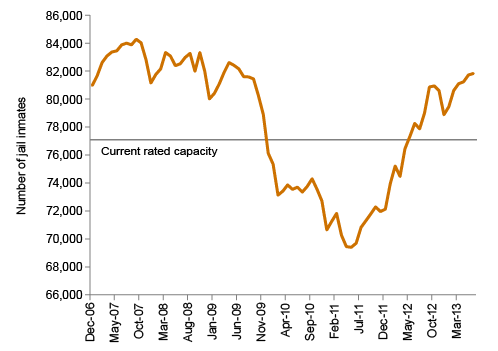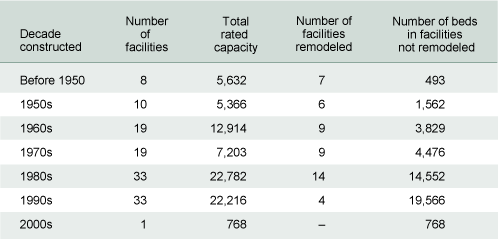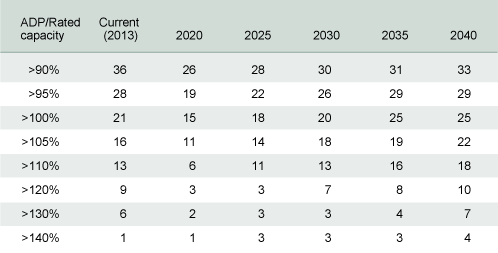Summary
Now that California has shifted responsibility for many criminal offenders to the counties, county jail systems face greater capacity challenges. This report highlights two important factors in addressing jail capacity constraints: aging jail facilities and long-term needs. We show that a number of facilities are old and likely in need of costly updates or replacement and that growth in the state’s population is likely to exert significant pressure on the county jail system. Our analysis suggests that a thoughtful combination of further jail construction and decreased reliance on incarceration is needed, given the magnitude of the current and future jail needs.
County Jails Face Pressures and Challenges
Motivated by a federal court ruling, California shifted significant responsibilities from its overcrowded and expensive state prison system to the counties. This reform-known as realignment-eliminated the practice of returning technical parole violators to state prison, designated a series of lower-level offenses that are now punishable by jail sentences rather than prison sentences, and greatly increased incentives for local criminal justice systems to use alternatives to incarceration.
With new responsibilities and a significant increase in the average daily jail population (ADP), California’s already crowded county jails face new pressures and challenges. Moreover, many county facilities were built several decades ago and were not designed for long-term detention.
To address these constraints, the state has provided funding for jail expansion. Two measures, AB 900 (2007) and SB 1022 (2012), allocated $1.2 billion and $500 million respectively for new jail construction. The legislature passed AB 900 to help alleviate overcrowding in both state prisons and county jails. In its two phases, AB 900 provided 21 counties with funding for 9,768 new beds.1 In June 2012, SB 1022 made additional funds available to cover the cost of providing 2,221 new beds in 15 counties.2
However, there may still be a need for additional funding. In the latest round of SB 1022 allocations, 36 counties requested funding but only 15 received it. Most recently, Governor Brown’s 2014-15 proposed budget included $500 million in lease-revenue bonds for county jail construction. Citing aging facilities and overcrowding, the governor wants to fund new facilities and programming space for counties working to succeed under realignment.3
This suggests the need for more capacity in both the short and long term. In assessing capacity needs, it is important to examine current jail capacity and conditions-including the age of existing jail facilities-and consider the impact of population growth on future jail needs.
Current Conditions
Realignment brought the statewide ADP close to the peak levels observed in 2006-2007 (Figure 1). Even at recent low points of statewide jail population, county jails did not have a large number of open beds. With no new construction since 2005, statewide rated jail capacity has remained around 77,000 beds.4 For much of this period, statewide jail ADP exceeded the rated capacity of county jails-by at least 3,000 and as many as 7,000 inmates.5 In June 2013, the most recent month for which data is available, ADP exceeded capacity by 5,000.
Figure 1. California’s County Jail ADP,
December 2006-2013

SOURCE: Jail Profile Survey 2006-2013, Board of State and Community Corrections.
NOTE: All calculations include Santa Ana Police Facility.
In that same month, 55 of the 123 jail facilities in California housed more inmates than their rated capacity. Furthermore, 39 jail facilities in 19 counties faced court-ordered jail population caps, which require them to release inmates when ADP reaches the level set by the court. Some counties have released inmates under voluntary population caps, but over the six-month period between January and June 2013, 84 percent (65,928) of the 78,359 capacity releases statewide were in counties operating under court orders.6
Jail Populations Are Changing
In addition to housing parole violators who would have gone to state prison before realignment, jails now house offenders convicted of felonies, some of whom are serving substantially longer sentences than the pre-realignment county maximum of one year.
These changes pose a number of challenges for counties. The increased number of offenders, especially those serving longer terms, increases the need for medical and mental health beds, as well as programming and recreation spaces. Also, there are concerns about increased violence, both between inmates and between inmates and staff. There is no publicly available statewide data regarding inmate-on-inmate assaults in county jails, but several counties reported increased jail violence in their SB 1022 applications and the issue has been noted in local media.7 Data from the BSCC shows that the number of reported inmate assaults on staff were substantially higher in the first six months of 2013 (546), compared to the first six months of 2011 (440).8 Furthermore, the increase in maximum- and medium-security inmates makes it more difficult to manage jail beds effectively.9 The challenges include matching inmates to appropriate types of beds, housing higher-security inmates in facilities not designed for them, increased flight risk, and inefficient use of space.10
There are concerns about increased violence,
both between inmates and between inmates and staff.
The recent increases in ADP and changes in the inmate population have raised concerns about new lawsuits. Since the implementation of realignment, Alameda, Fresno, Monterey, and Riverside have faced new inmate lawsuits over jail conditions and overcrowding.
Many Facilities Are Old and Outdated
The age of county facilities presents a serious challenge. In the 1980s, jail construction began to move toward podular designs that allow for direct supervision of inmates.11 Many facilities still in use are configured in a traditional linear “jail-steel” design, fostering nondirect supervision. Traditional “jail-steel” linear facilities are more costly to operate and pose significant challenges to updating control-room and surveillance technology to current industry standards.12 Moreover, unlike state prisons, all existing county jail facilities were constructed for the mission of holding pre-trial inmates and sentenced offenders for short periods. They were not designed to provide medical, mental health, and recreational services for sentenced individuals serving more than a year. Now that realignment is changing the jail inmate population, these services are increasingly important.
Recent construction funding applications show that counties are at times opting to update their facilities to fulfill new responsibilities at the cost of reducing much needed system capacity. Fresno County’s SB 1022 funding request is a good example. Fresno’s South Annex Facility was built in 1941 and has serious structure and maintenance issues. Even though the county faces jail overcrowding, it submitted a plan to replace the South Annex with a facility that will have programming and medical care space, but fewer beds overall. Other SB 1022 applications reveal a similar willingness to sacrifice current or needed future capacity in order to update aged and inadequate structures-even in seriously capacity-constrained counties such as Butte, Merced, and Tulare.
Additional beds and programming space funded by AB 900 and SB 1022 may help address the problems of aging facilities and outdated design, but some counties will still be operating aging facilities. Of the 123 jail facilities in California, 56 (more than 40%) were completed in the 1970s or earlier. Counties have remodeled some of these aging facilities, but 25 jails are still configured according to the older design.13 These 25 facilities have a rated capacity over 10,300 jail beds, or slightly more than 13 percent of the total beds statewide.
Replacing all of these aging facilities would require substantial state and/or local funding. For example, 18 facilities totaling more than 11,000 beds were built in the 1950s or earlier (Table 1). It could cost more than $3 billion (not including the cost of bond financing) to replace them.14 We do not yet have adequate information to determine whether remodeling could produce adequate and effective jail facilities at a lower cost; this could be a viable option in some cases. However, for older facilities built in relatively dense urban areas, it may not be possible to add modular structures.
Table 1. ages of california’s county jails
(listed by decade)

SOURCE: Board of State and Community Corrections.
NOTE: Kings County Main County Jail is not included in this table because the BSCC did not list an original construction date. Most of the remodels occurred in the late 1990s and 2000s, with the most recent in 2006.
Future Needs
In addition to being costly, jail expansions require long-term planning. The AB 900 experience illustrates this. Although the bill passed in 2007, as of early 2014 only three projects were completed, and some counties were still in the planning phase. The BSCC included a preference criterion for “shovel ready” projects in the SB 1022 application process, but it typically takes five to seven years to go from the planning stage to completion.15 Local and state stakeholders need to consider both the current and long-term needs of county jail systems in their expansion discussions.
It is difficult to be certain about future jail capacity needs. For one thing, these needs could be affected by changes to criminal justice policies’such as a rollback of realignment, or new sentencing and jail practices. In fact, three changes to realignment currently under consideration could reduce both near- and long-term jail capacity needs. The governor has proposed to send county inmates sentenced to more than 10 years to state prison.16 He has also proposed split sentences as the norm for local offenders.17 Finally, increased use of risk assessment for low-risk inmates awaiting trial would free up some jail beds. Of course, it is difficult to predict the impact of these measures. It is also difficult to account for factors like broader crime and arrest trends, which are affected by local budgets and the number of law enforcement officers. Nonetheless, we can make basic jail capacity projections based on a fundamental and relatively reliable determinant: population growth.18
Currently, county jails statewide are operating at 105 percent of rated capacity. A look at Table 2 shows that 21 counties are above capacity, including some of the state’s largest: Los Angeles, Orange, Riverside, San Bernardino, and Santa Clara. There are some large counties with ample jail space, such as Alameda, Contra Costa, and San Francisco. But for the most part, jail capacity is less strained in small counties such as Sierra, Modoc, Trinity, Calaveras, and Glenn.
Table 2. Number of counties with adp/rated capacity above 90 percent

SOURCE: Authors’ calculations based on Department of Finance Population projections and data from the Board of State and Community Corrections.
NOTE: ADP projections are based on Department of Finance’s county-level projections for the population age 15-39. No other factors potentially affecting jail populations’such as local and state policies and practices, as well as crime and arrests-are factored in.
Planned expansions under AB 900 and SB 1022 will ease overcrowding in many counties: the number operating above rated capacity is projected to decline from 21 to 15 by 2020.19 For example, Riverside County’s ADP/rated capacity ratio is projected to decline from 101 percent to about 88 percent, while San Bernardino is projected to go from almost 105 percent to about 90 percent. Some counties will still be housing substantially more inmates than their facilities were designed to hold, but the number above 120 percent of capacity is projected to decline from nine to three. This suggests that expansions have been planned for the counties with the greatest needs.
Projections based on planned expansions from AB 900 and SB 1022 indicate that population growth in future decades could bring jail overcrowding to roughly current levels-or higher, when aging facilities are factored in. Future need is most obvious in areas expected to experience the strongest population growth. In many coastal counties, the population age 15 to 39 is projected to increase modestly, and declines are predicted in large counties like Los Angeles, Orange, and Alameda. But substantial growth is expected in inland counties like Riverside, San Bernardino, Fresno, and San Joaquin. If there are no additional expansions or other efforts to reduce the jail population, all four of these counties are likely to be above rated capacity in 2040, particularly Fresno (172%) and San Joaquin (187%). Overall, 25 counties are projected to hold more inmates than their jails were designed to house by 2040, and 10 counties will be at or above 120 percent of their rated capacity. Of course, court-ordered jail population caps will prevent some of these counties from reaching these levels. This means that if no actions are taken by the state or counties, capacity constrained releases are likely to increase.
Some counties will still be housing substantially more inmates than their facilities were designed to hold.
It would cost about $1.2 billion to add enough capacity-4,300 beds-to bring statewide ADP levels down to full capacity in 2040.20 A more manageable level of 90 percent of capacity would require as many as 14,600 new beds, at a total cost of about $4 billion.21 Because construction costs account for only 10 percent of the lifetime cost of a new facility, and because counties are largely responsible for operating costs, they have considerable incentives to pursue alternatives to incarceration. Potential tools to manage jail population pressures include releases based on risk assessment (possibly accompanied with electronic monitoring, work release programs, day reporting center requirements, etc.); split sentencing, and shorter but “swift and certain” sanctions for parole and probation violations, such as “flash incarceration.” Importantly, but with less immediate effects, the identification and implementation of effective reentry services may also address the challenges faced by county jails.
Conclusion
Clearly, California faces some challenging decisions about jail expansions and population management. Without further jail expansion and/or new policies and practices that reduce incarceration, capacity constraints will be more severe in 2040 than they are today. Moreover, a substantial number of aging jail facilities need-or will soon need-to be replaced by facilities in which counties can provide effective services and programs as well as safe environments for inmates and staff.
Given the substantial amount of time and money required to design and build new facilities, California needs a long-term plan that takes population growth into account, and the state needs to make judicious funding decisions. Since one of the goals of realignment is for counties to pursue alternatives to incarceration, it seems reasonable to give preference to counties that have addressed jail capacity challenges through tools like split sentencing, alternative custody programs, and risk assessments for releases of pre-trial detainees.22
Our analysis suggests that the jail capacity challenge is unlikely to be met exclusively through either increased jail construction or decreased reliance on incarceration. Meeting this challenge will probably require a thoughtful combination of efforts carried out jointly by the state and the counties.
Additional tables on AB 900 and SB 1022 jail construction projects, court-ordered population caps, county jail construction and remodel years, and current and projects jail capacity and needs are available in the PPIC data depot.
